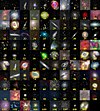NGC 4697
| Galaxy NGC 4697 |
|
|---|---|

|
|
| High-resolution image of the elliptical galaxy NGC 4697, created with the help of the Hubble Space Telescope | |
| AladinLite | |
| Constellation | Virgin |
|
Position equinox : J2000.0 , epoch : J2000.0 |
|
| Right ascension | 12 h 48 m 35.9 s |
| declination | -05 ° 48 ′ 03 ″ |
| Appearance | |
| Morphological type | E6 / LLAGN |
| Brightness (visual) | 9.2 likes |
| Brightness (B-band) | 10.2 mag |
| Angular expansion | 7.2 ′ × 4.7 ′ |
| Position angle | 70 ° |
| Surface brightness | 13.1 mag / arcmin² |
| Physical data | |
| Affiliation |
Virgo II group NGC 4697 group LGG 314 |
| Redshift | 0.004140 ± 0.000008 |
| Radial velocity | 1241 ± 2 km / s |
|
Stroke distance v rad / H 0 |
(51 ± 4) · 10 6 ly (15.6 ± 1.1) Mpc |
| diameter | 95,000 ly |
| history | |
| discovery | William Herschel |
| Discovery date | April 24, 1784 |
| Catalog names | |
| NGC 4697 • PGC 43276 • MCG -01-33-010 • 2MASX J12483590-0548030 • GC 3227 • H I 39 • h 1436 • NSA 142365 • LDCE 904 NED252 | |
NGC 4697 is an elliptical galaxy with an active nucleus of the Hubble type E6 in the constellation Virgo on the ecliptic . It is estimated to be 51 million light years away from the Milky Way and has a diameter of around 115,000 ly.
In the same area of the sky are the galaxies NGC 4705 , NGC 4718 , NGC 4731 , IC 825 , among others .
The object was discovered by William Herschel on April 24, 1784 .
Web links
Commons : NGC 4697 - collection of images, videos, and audio files

